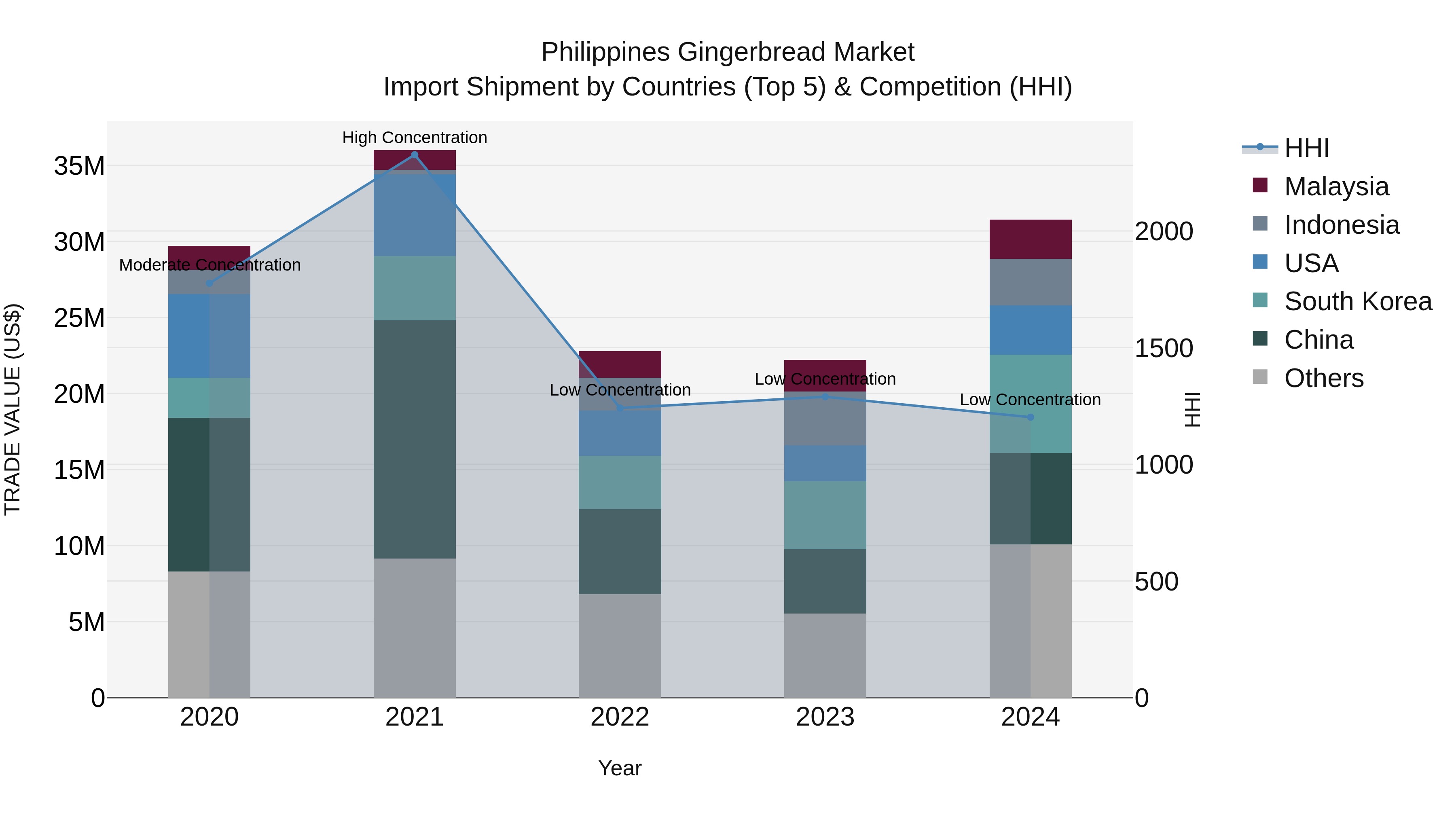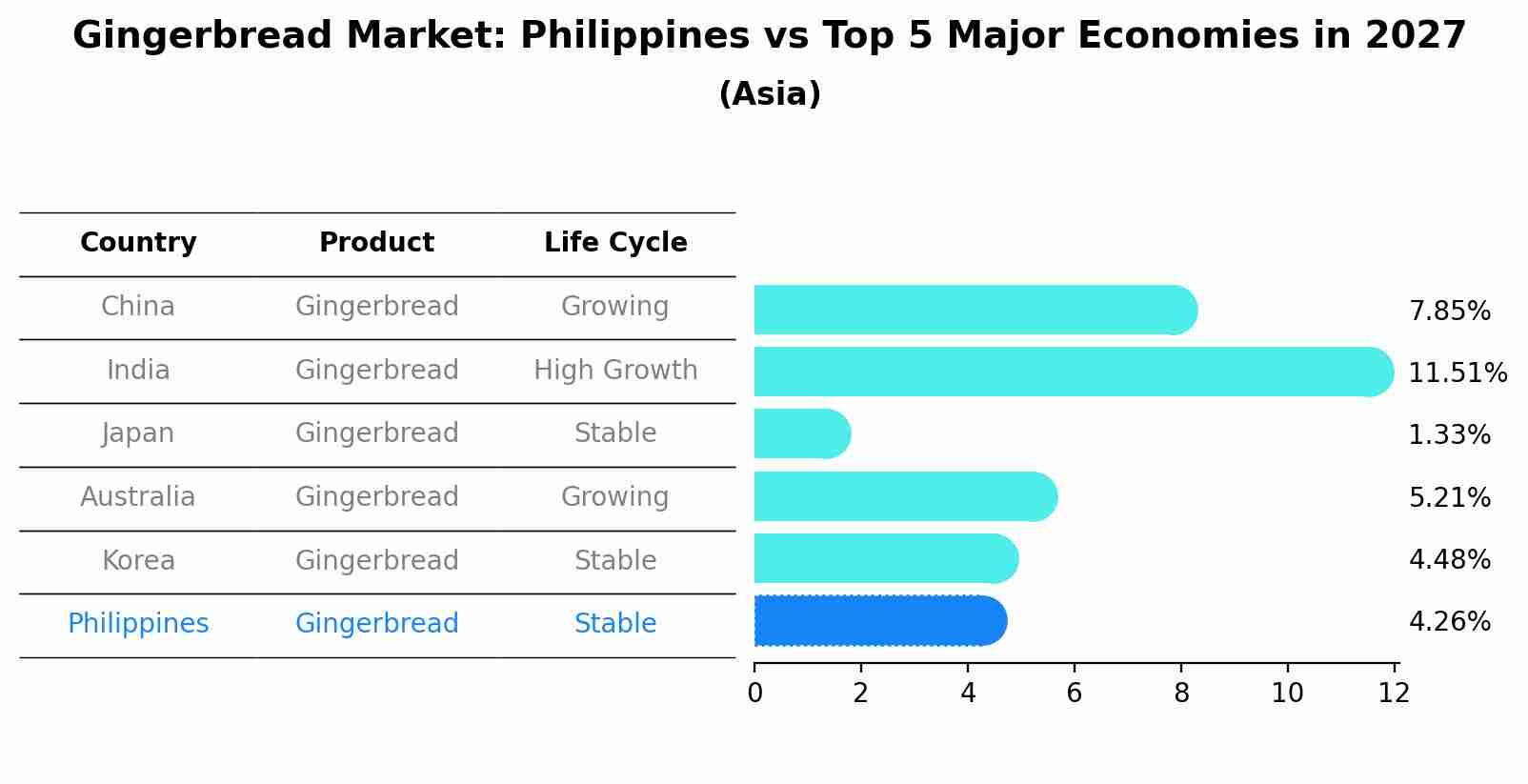Philippines Gingerbread Market (2025-2031) Outlook | Trends, Analysis, Value, Size, Forecast, Industry, Companies, Share, Growth & Revenue
| Product Code: ETC410845 | Publication Date: Oct 2022 | Updated Date: Nov 2025 | Product Type: Market Research Report | |
| Publisher: 6Wresearch | Author: Ravi Bhandari | No. of Pages: 75 | No. of Figures: 35 | No. of Tables: 20 |
Philippines Gingerbread Market Top 5 Importing Countries and Market Competition (HHI) Analysis
Philippines` gingerbread import market saw significant growth in 2024, with top exporters being South Korea, China, USA, Indonesia, and Thailand. The low concentration of the Herfindahl-Hirschman Index (HHI) indicates a diverse market landscape. The compound annual growth rate (CAGR) from 2020 to 2024 stood at 1.42%, while the impressive growth rate of 41.57% from 2023 to 2024 signals a promising outlook for the industry. This data suggests a growing demand for gingerbread imports in the Philippines, with a varied mix of countries contributing to the market expansion.

Gingerbread Market: Philippines vs Top 5 Major Economies in 2027 (Asia)
The Gingerbread market in Philippines is projected to grow at a stable growth rate of 4.26% by 2027, within the Asia region led by China, along with other countries like India, Japan, Australia and South Korea, collectively shaping a dynamic and evolving market environment driven by innovation and increasing adoption of emerging technologies.

philippines gingerbread market Synopsis
The Philippines gingerbread market showcases a unique blend of traditional flavors and modern innovation. While gingerbread may have historical ties to Western cultures, its adoption in the Philippines reflects the country`s openness to global culinary influences. The market has gained traction during festive seasons and celebrations, with gingerbread products becoming popular gifts and treats. The synergy between traditional elements and contemporary adaptations underscores the gingerbread market`s ability to bridge culinary heritage with contemporary demands.
Drivers of the Market
The Philippines gingerbread market experiences growth due to a combination of factors. Gingerbread, with its blend of spices and unique taste, has gained popularity not only as a holiday treat but also as an everyday snack. The market is often driven by seasonal demand during festive periods, as gingerbread is associated with celebrations. Furthermore, creative product innovations and marketing strategies by manufacturers contribute to sustaining year-round interest in gingerbread products.
Challenges of the Market
The Philippines gingerbread market may face challenges related to consumer preferences and market competition. Gingerbread products might be considered seasonal or specialty items, which can impact year-round demand. Additionally, the market might face competition from a variety of baked goods and snacks. Maintaining consistent product quality, freshness, and addressing concerns related to allergens, dietary restrictions, and ingredient sourcing are key challenges. Marketing and educating consumers about gingerbread`s taste, nutritional value, and cultural significance could also be essential in driving demand.
COVID-19 Impact on the Market
The Philippines gingerbread market may have faced challenges during the COVID-19 pandemic due to disruptions in the hospitality and tourism sectors. Gingerbread products are often associated with holiday gatherings and tourism-related activities, which might have been affected by lockdowns and restrictions. However, there could also have been a demand for comfort foods like gingerbread as people spent more time at home. The market`s performance could have been influenced by the balance between decreased demand from certain sectors and potential growth in others.
Key Players in the Market
Gingerbread products are not as mainstream in the Philippines as some other markets, but they do find a place especially during the holiday season. Local bakeries and confectioneries often dominate this market. While specific key players might not be as widely recognized, establishments like Goldilocks Bakeshop and other regional bakeries create gingerbread products as part of their holiday offerings. Additionally, various home-based bakers and smaller businesses contribute to the gingerbread market on a local level.
Key Highlights of the Report:
- Philippines Gingerbread Market Outlook
- Market Size of Philippines Gingerbread Market, 2024
- Forecast of Philippines Gingerbread Market, 2031
- Historical Data and Forecast of Philippines Gingerbread Revenues & Volume for the Period 2021-2031
- Philippines Gingerbread Market Trend Evolution
- Philippines Gingerbread Market Drivers and Challenges
- Philippines Gingerbread Price Trends
- Philippines Gingerbread Porter's Five Forces
- Philippines Gingerbread Industry Life Cycle
- Historical Data and Forecast of Philippines Gingerbread Market Revenues & Volume By Application for the Period 2021-2031
- Historical Data and Forecast of Philippines Gingerbread Market Revenues & Volume By Household for the Period 2021-2031
- Historical Data and Forecast of Philippines Gingerbread Market Revenues & Volume By Commercial for the Period 2021-2031
- Historical Data and Forecast of Philippines Gingerbread Market Revenues & Volume By Distribution Channel for the Period 2021-2031
- Historical Data and Forecast of Philippines Gingerbread Market Revenues & Volume By Online for the Period 2021-2031
- Historical Data and Forecast of Philippines Gingerbread Market Revenues & Volume By Offline for the Period 2021-2031
- Philippines Gingerbread Import Export Trade Statistics
- Market Opportunity Assessment By Application
- Market Opportunity Assessment By Distribution Channel
- Philippines Gingerbread Top Companies Market Share
- Philippines Gingerbread Competitive Benchmarking By Technical and Operational Parameters
- Philippines Gingerbread Company Profiles
- Philippines Gingerbread Key Strategic Recommendations
Frequently Asked Questions About the Market Study (FAQs):
- Single User License$ 1,995
- Department License$ 2,400
- Site License$ 3,120
- Global License$ 3,795
Search
Thought Leadership and Analyst Meet
Our Clients
Related Reports
- Canada Oil and Gas Market (2026-2032) | Share, Segmentation, Value, Industry, Trends, Forecast, Analysis, Size & Revenue, Growth, Competitive Landscape, Outlook, Companies
- Germany Breakfast Food Market (2026-2032) | Industry, Share, Growth, Size, Companies, Value, Analysis, Revenue, Trends, Forecast & Outlook
- Australia Briquette Market (2025-2031) | Growth, Size, Revenue, Forecast, Analysis, Trends, Value, Share, Industry & Companies
- Vietnam System Integrator Market (2025-2031) | Size, Companies, Analysis, Industry, Value, Forecast, Growth, Trends, Revenue & Share
- ASEAN and Thailand Brain Health Supplements Market (2025-2031) | Strategy, Consumer Insights, Analysis, Investment Trends, Opportunities, Growth, Size, Share, Industry, Revenue, Segments, Value, Segmentation, Supply, Forecast, Restraints, Outlook, Competition, Drivers, Trends, Demand, Pricing Analysis, Competitive, Strategic Insights, Companies, Challenges
- ASEAN Bearings Market (2025-2031) | Strategy, Consumer Insights, Analysis, Investment Trends, Opportunities, Growth, Size, Share, Industry, Revenue, Segments, Value, Segmentation, Supply, Forecast, Restraints, Outlook, Competition, Drivers, Trends, Demand, Pricing Analysis, Competitive, Strategic Insights, Companies, Challenges
- Europe Flooring Market (2025-2031) | Outlook, Share, Industry, Trends, Forecast, Companies, Revenue, Size, Analysis, Growth & Value
- Saudi Arabia Manlift Market (2025-2031) | Outlook, Size, Growth, Trends, Companies, Industry, Revenue, Value, Share, Forecast & Analysis
- Uganda Excavator, Crane, and Wheel Loaders Market (2025-2031) | Strategy, Consumer Insights, Analysis, Investment Trends, Opportunities, Growth, Size, Share, Industry, Revenue, Segments, Value, Segmentation, Supply, Forecast, Restraints, Outlook, Competition, Drivers, Trends, Demand, Pricing Analysis, Competitive, Strategic Insights, Companies, Challenges
- Rwanda Excavator, Crane, and Wheel Loaders Market (2025-2031) | Strategy, Consumer Insights, Analysis, Investment Trends, Opportunities, Growth, Size, Share, Industry, Revenue, Segments, Value, Segmentation, Supply, Forecast, Restraints, Outlook, Competition, Drivers, Trends, Demand, Pricing Analysis, Competitive, Strategic Insights, Companies, Challenges
Industry Events and Analyst Meet
Whitepaper
- Middle East & Africa Commercial Security Market Click here to view more.
- Middle East & Africa Fire Safety Systems & Equipment Market Click here to view more.
- GCC Drone Market Click here to view more.
- Middle East Lighting Fixture Market Click here to view more.
- GCC Physical & Perimeter Security Market Click here to view more.
6WResearch In News
- Doha a strategic location for EV manufacturing hub: IPA Qatar
- Demand for luxury TVs surging in the GCC, says Samsung
- Empowering Growth: The Thriving Journey of Bangladesh’s Cable Industry
- Demand for luxury TVs surging in the GCC, says Samsung
- Video call with a traditional healer? Once unthinkable, it’s now common in South Africa
- Intelligent Buildings To Smooth GCC’s Path To Net Zero


















